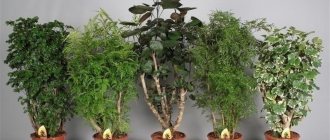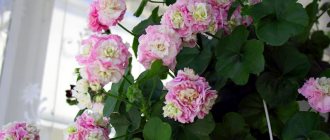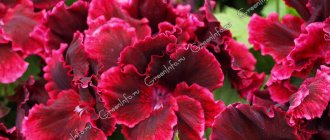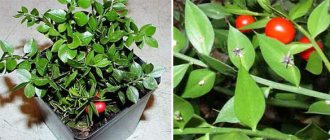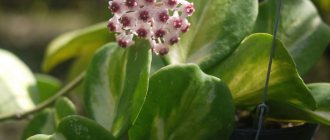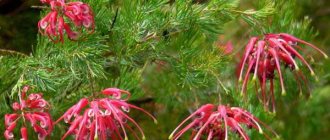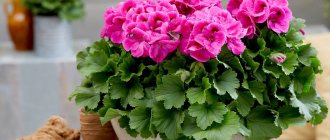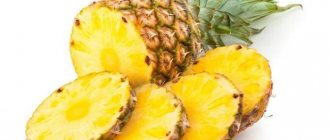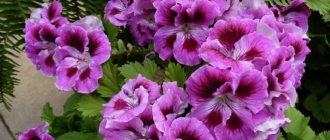The eye-catching inflorescences of pelargonium on the windows surprise few people. Erect bushes of pelargonium or zonal geranium are well known and loved by flower growers, but the ampelous varieties are not yet so well known and are only gaining popularity. But once you plant such a plant in a hanging pot or use it to decorate window sills and balconies, it becomes clear that unpretentious but incredibly beautiful pelargoniums are simply irreplaceable in landscaping and can transform any corner.
In addition, Pelargonium peltatum, ampelous ivy-leaved pelargonium can be used on vertical surfaces, and, if desired, forms a dense flowering carpet if planted in the garden on a flat area. How to grow, propagate and care for pelargonium so that the plants enjoy flowering for as long as possible, are attractive and healthy?
Growing ivy-leaved pelargonium
The name ivy-leaved pelargonium, shown in the photo, is due to the shape of the leaves, the same as those of ivy, five-lobed, leathery and smooth. In nature, thin but quite strong shoots of this type of pelargonium are able to climb rocky slopes, due to which the plant disperses. But since pelargonium is grown at home as an ampel crop, stems up to 70–100 cm long form beautiful cascades and, hanging from a flowerpot or flowerpot, give the window, balcony or terrace additional decorativeness.
Umbrella inflorescences, combining from 6 to 15 flowers, are formed in the axils of green or, depending on the variety, variegated leaves. Today you can find ivy-leaved pelargonium with both simple and spectacular double flowers of all tones and shades. It is not uncommon to find varieties with contrasting spots on the petals, stripes and a brightly outlined border, as in the presented photo of ivy-leaved pelargonium.
Like other related species, ampelous pelargonium loves bright sun, develops well and blooms in long daylight hours. The plant easily tolerates dry periods, and in the summer it blooms beautifully outside the house, for example, outside the window in a balcony box or in a flowerpot on a personal plot. At the same time, the optimal maintenance temperature is 20–25 °C, but even on hotter days with good watering, the bushes do not lose their decorative appearance, do not wither and do not stop blooming.
If the ivy-leaved ampelous pelargonium is hardened, it is not afraid of cold snaps, but sub-zero temperatures are destructive for plants.
When choosing a soil mixture for planting plants, they try to make the soil moisture-absorbing, loose and nutritious. However, stagnation of moisture in the soil is dangerous due to rotting of the root system, so care is planned so that the surface of the soil dries out from one watering to the next. Active growth of bushes begins in March and ends with the beginning of autumn. During this period, ivy-leaved pelargonium blooms profusely, and plants, especially those in pots, must be fed.
It is best to support the bushes with fertilizing once a week, alternating organic matter and mineral supplements, but do not get carried away with adding nitrogen-containing substances.
If the soil is oversaturated with nitrogen, pelargoniums react with rapid growth of shoots and foliage, but flowering noticeably fades, fewer buds are formed and, if the feeding scheme is not changed, it ends completely. To form lush inflorescences of ivy-leaved pelargonium from spring to the end of summer, regular addition of potassium and phosphorus mixtures is required.
Complex supplements with a predominance of these elements are also suitable. Magnesium sulfate also becomes an excellent help for the gardener. As a top dressing, this compound provides plants with magnesium and sulfur and provokes long-term formation of buds.
When caring for pelargonium and propagating bushes, it is important to take into account that not only nitrogen causes the growth of greenery and stops flowering. An overly large plant pot produces the same effect. Therefore, when planting, it is better to give preference to containers only a finger’s thickness larger than the existing diameter of the root system. You can also plant several bushes in one flowerpot or balcony box, which will prevent the plants from “forgetting” about the formation of buds, and will give the composition originality and splendor.
At the end of winter or in March, bare stems are pruned and shoots are pinched, which causes ampelous ivy-leaved pelargonium to branch.
How does an ivy-shaped plant variety differ from a regular one?
Ivy geranium is an evergreen plant of the Geranium family. It got its name because of the shape of the leaves, which are similar to ivy leaves. If the common one is soft with a velvety surface, then the ivy leaf one is hard and smooth to the touch. Their general characteristic is long branches that hang down. The stem of an ordinary geranium is vertical and not long, but that of an ivy-leaved one is flexible and curly. In this case, shoots can grow up to 1 meter.
Unlike other species, ivy-leaved geranium is unpretentious in care and even a beginner can handle it. It blooms profusely and takes root quickly, both in water and in soil. Flowers come in various shapes and colors. But compared to ordinary geranium, it does not tolerate winter well, does not like drafts, and it definitely requires additional illumination with phytolamps. At the same time, it is susceptible to root rot.
Ampelous pelargonium - summer outdoors
If pelargonium decorates a room, it does not have to adapt to changes in humidity, light and temperature; it blooms all summer in the most comfortable conditions, which cannot be said about plants displayed in the garden or outside the window. To gradually acclimatize ivy-leaved ampelous pelargoniums, bushes planted in selected containers with the arrival of heat begin to be exposed to the street, making sure that the plants are not exposed to sub-zero temperatures and are not exposed to direct sunlight for a long time.
In May or a little later, when the time of frost has passed, pelargoniums can be sent to a permanent place, where they will spend the whole summer, until autumn, when the air temperature begins to drop to 10–15 °C. Ivy-leaved pelargoniums quickly enter the flowering season and are very attractive if bushes with contrasting flower colors bloom nearby.
Features of flowering
This flower is more familiar to ordinary people under the name ivy-leaved geranium. The peculiarities of caring for this plant are largely determined by the phases of development of this plant at different periods of time. During periods of rest and activity, conditions of detention and rules of care have certain features.
Rest period
Pelargonium Sutarve Clara San - variety characteristics and cultivation
Pelargonium refers to plants in which the dormant period is not particularly pronounced. It slows down its growth and does not bloom, but does not go into a completely dormant state. This period falls in winter.
In winter, stop applying fertilizers and reduce watering to a minimum. It is also advisable to move the flower to a more shaded place.
Activity period
The spring-summer period is a time of active growth for pelargonium. This is also the time of peak flowering. Sometimes you can see flowering in winter, but this is rather an exception to the rule.
During the active phase, the plant requires a lot of strength. For this reason, pelargonium is regularly fed with fertilizers and watered abundantly before the onset of cold weather.
Types and shape of flowers
Flowers can vary greatly in flower shape and color. Color can vary from bright pink to deep scarlet. Varieties with snow-white flowers, for example White Split, are very attractive.
The shape of the flowers can be:
- simple - the petals are arranged in one row;
- semi-double - have 2-3 rows of petals on flowers;
- terry - the petals are densely arranged in several rows.
Attention! The many species and varieties of pelargonium allow each gardener to choose a plant with a favorite shade of flowers and a preferred shape.
Wintering conditions for ampelous ivy-leaved pelargonium
With the onset of autumn, pelargoniums are returned indoors, but not to warm rooms, but conditions are created for them that are close to winter in the plants’ homeland - South Africa.
- To do this, choose a bright, cool and dry place for pelargoniums.
- Provide a temperature in the range of 7–15 °C.
- Reduce watering, only moistening the soil to avoid root death.
- The leaves and stems are not moistened; fertilizing is completed a month before the start of wintering.
In the off-season, plants require practically no special care, but you should not propagate pelargonium at this time. The cuttings take root poorly, and the bushes turn out weak and elongated. If it is difficult to create a semblance of a South African winter at home, in August the apical cuttings are cut from large plants and rooted. Young plants can overwinter on cool window sills inside the house, and in the spring they can be planted on the balcony or in the garden.
Varieties of fragrant pelargoniums
- Felt pelargonium P. tomentosum Chocolate Mint (syn. Chocolate Peppermint) is low-growing, up to 30 cm tall, with slightly hanging shoots. The leaves are medium to large, deeply lobed, soft, velvety, with a chocolate brown spot in the center, and smell of mint. The flowers are pale pink, with purple feathers on the upper petals.
- Pelargonium capitatum P. capitatum Attar of Roses - up to 45 cm tall, with large trilobed leaves that have a strong rose aroma. The flowers are lilac-pink, with a burgundy throat.
Pelargonium curly P. crispum Cy's Sunburst - has small lemon-scented corrugated variegated foliage - green with a thin golden border. The flowers are pink.
- Pelargonium P. quercifolium Giant Oak - with very large, lobed leaves with a balsamic scent.
- Pelargonium pink P. radens Red-Flowered Rose is an openwork pelargonium with grayish-green palmate foliage (for which it is called Crow's Feet) and abundant red-pink (brighter than the main species) flowers. Very drought resistant.
Pink pelargonium P. radens Radula - leaves are less finely cut than those of the main species (P. radens), with a less bright aroma. The flowers are small, lilac-pink.
Reproduction of ivy-leaved pelargonium
You can propagate your favorite varieties of ampelous ivy-leaved pelargonium by cuttings and sowing seeds.
The first method is used more often, although the seeds of this species germinate well and produce many powerful young bushes for planting. You can sow seeds from November to April, taking into account that the sprouts in winter definitely need additional lighting, providing 12 hours of daylight.
Diseases of ivy-leaved pelargonium
Since pelargoniums are often planted in the garden or decorate balconies in the summer, it is difficult for them to avoid fluctuations in humidity and temperature. Therefore, when seeing rusty or dry spots, light areas or a yellow mosaic pattern on the leaves, the gardener should be wary and think about the health of the plant.
Most often, ivy-leaved pelargoniums suffer from attack by harmful fungi, viral mosaic and chlorosis.
Depending on the nature of the disease, the bushes must be treated with special protective equipment, fertilizing is adjusted and the watering schedule is revised. After all, it is high humidity, lack of lighting and weak plants that are the main causes of pelargonium diseases. As a preventive measure, before planting pelargoniums, be sure to disinfect the soil and avoid excessive bush density, which interferes with ventilation and provokes the development of fungi and pests.
When loosening the soil under the plants, remove yellowed and fallen leaves, cut off wilted inflorescences and prevent the soil from becoming waterlogged.
Video about pruning and rooting pelargonium cuttings in autumn
All summer, the thyroid pelargonium (Pelargonium peltatum), a close relative of the well-known indoor geranium, delighted us with its lush flowering. An evergreen pelargonium culture with long (up to 1 meter) creeping shoots, with bright green, decorative leaves and beautiful inflorescences with star-shaped flowers.
The hanging plant is an excellent decoration for balconies, window openings, terraces, pedestals, and is planted as a creeping crop in carpet beds.
Possible problems
Pests and diseases
The following diseases can affect ivy geranium:
- Botrytis mushroom . It can be distinguished by the presence of brown spots covered with gray fluff. The number of spots will gradually increase and the leaves will fall off. Excess moisture can affect the spread of the fungus.
- Root system rot . Occurs due to water stagnation and increased nitrogen concentration. Over time, the disease affects the stem, causing its color to turn brown and then black.
- Bacterial diseases caused by microorganisms . Blackening and wilting of the stem occurs.
Among the pests that pose a danger to the plant are:
- Caterpillars, slugs . These parasites feed on geranium foliage.
- Ticks . These pests thrive in hot and dry weather. You can notice the parasite by yellow spots on the leaves, as a result of which they gradually fade.
- Aphid . Curled, yellowed leaves will help identify the presence of a pest.
- Thrips . They appear in the form of corky growths on the leaves, which as a result become deformed.
Treatment
To treat a flower for these diseases, it is necessary to transplant the plant into another container, remove all affected parts, and then treat it with fungicides.
Important! As a preventive measure, you need to regularly spray the geranium and weed the soil.
There is a scheme for pest control:
- Slugs – use systemic insecticides.
- Ticks – treat with soap and mineral oil, and in case of extensive damage, use chemicals:
- Lightning;
- Detox;
- Bi-58.
- Aphid – treatment of the plant with an ash-soap solution, as well as preparations:
- Spark;
- Aktara.
- Thrips – install blue sticky traps, use the following preparations:
- Aktara;
- Biotlic.
Geranium ivy is a very beautiful plant that needs to be cared for regularly. It is enough to make a small mistake, as diseases and pests immediately attack the flower, which can then be very difficult to save.
There is an amazing variety of types and varieties of geranium - this beautiful and incredibly fragrant flower. On our website in a number of articles you can learn about the white and black varieties of geranium, about rosebud and fragrant, royal and tulip-shaped, beautiful Roberta, about the varieties Rosanna and Angel.
How to preserve pelargoniums until next season?
Before the onset of frost, it is necessary to take care of the heat-loving plants of our garden - make shelters for them or send them to warm rooms for the winter. Let's think about a “winter apartment” for our pelargonium until the next summer season.
Let's find a place in the house or apartment where flowerpots with ivy-leaved pelargonium plants could overwinter. For proper storage, we comply with the following conditions:
- Good room lighting;
- Optimum air temperature from +5 to +12;
- Rare watering to prevent root rotting.
For wintering, you can use closed loggias, balconies, bright attics and cold storage rooms, but so that the temperature does not fall below 0* and does not rise above +16*. At the end of September, we move the plant for wintering in a way convenient for you.
Pruning an old plant after flowering, taking cuttings
After the mother plant has finished flowering, apical cuttings are cut from it for rooting. Pelargoniums are very susceptible to fungal diseases, so it is advisable to make a cut on the mother plant above the node and be sure to treat the cut area with a fungicide, sprinkle with charcoal or sulfur, these measures will reduce the likelihood of stem rotting. It is optimal to carry out cuttings in warm weather, this also reduces the risk of disease. It is better not to remove old leaves that remain on the plant at this time, as side shoots will begin to grow more quickly. As young shoots grow, old leaves are removed. As soon as the young shoots grow 8-10 leaves, they are pinched.
To make the crown uniform and stimulate good flowering, old specimens are pruned immediately after winter rest, frail and diseased shoots are removed, long ones are shortened, leaving 2 to 5 buds on each shoot. It is not advisable to prune in the fall, since at home, without strict adherence to cool wintering conditions, weak side shoots are formed that will have to be removed.
Autumn transplantation of pelargonium shoots before winter storage.
We are preparing the soil for replanting pelargonium bushes (shoots). To do this, mix peat, turf soil and sand in a ratio of 4:4:2 and fill the flowerpots, and if there is a lot of planting material, the boxes.
We cut off the tops of the shoots, leave them for green (mother) cuttings, and plant individual plants in containers and bring them into the house.
In winter, do not forget to “visit” the plants - remove yellow leaves and dead shoots. It is necessary to cut with scissors, being careful not to damage the axillary buds.
We water it rarely so that the earthen clod does not dry out. We turn the flowerpots twice a month so that the shoots grow evenly and the bushes form even and compact.
We send pelargonium to a “winter apartment” without transplanting.
In the second option: we bring the plant indoors without replanting, but only by shortening the shoots by 3-4 internodes. In February, before active growth begins, we transfer the pelargonium bushes with roots into fresh soil. If during the winter period the apical shoots grow, they need to be shortened again.
Trimming
The formation of ivy-leaved pelargonium involves timely pruning and pinching. This is a necessary measure to maintain the decorative quality of the hanging crop and stimulate flowering. How to prune ivy-leaved pelargonium correctly?
The main pruning occurs in autumn. The shoots are pruned heavily - leaving seven leaves. The basal shoots are not touched, only the axillary shoots are cut off. Dried and bare stems are also removed.
If during wintering the pelargonium has managed to grow, it is pruned again. Then, throughout the entire growing season, faded inflorescences and dried leaves are cut off, and the bushes are thinned out.
Caring for ivy-leaved pelargonium after flowering consists of removing faded peduncles, pruning and preparing for the dormant period. Feeding is kept to a minimum, watered less frequently, and the flower begins to gradually become accustomed to lower temperatures.
Propagation of pelargonium by green cuttings.
One of the reliable methods for storing pelargoniums in winter is the use of cuttings. We carry out cuttings in August - September or February - March. We take a plant with healthy and strong fleshy shoots and bright foliage.
We cut off the tops with 3-4 leaves and place the cuttings in a glass of water. After the roots have formed, we plant them in flowerpots or boxes.
You can skip the stage of germinating the cuttings in water, and immediately place them in a container with fertile and light soil. It is not recommended to make small mini-greenhouses; pelargonium cannot easily tolerate excess moisture.
Once every 1-1.5 months we apply complex fertilizer for flower plants. The cuttings take root quickly, within 2-4 weeks, and can grow on the windowsill all winter at room temperature, and in the spring we again send them to hanging flower pots or containers.
Differences
Although there are many similarities between the bushes, there are also differences. Experienced flower growers know it.
- It is impossible to cross geranium and pelargonium. By crossing plants, botanists do not obtain seeds. This is because their genetic codes are different.
- Geranium was first discovered in the temperate zone in the Northern Hemisphere, and pelargonium - in the southern regions. Therefore, the first blooms if the room temperature does not rise above +12°C, and the second withers during such a wintering.
- It is not necessary to leave pelargonium on the window in the summer if there is a gazebo or loggia. With the first frost, they bring the pot with it into the house and put it in its original place until next summer. Geranium grows and winters successfully in open ground without shelter. But this method of cultivation is not suitable for the Far Eastern and northern regions with harsh climatic conditions.
Application
The difference in the use of geranium and pelargonium is based on the fact that they belong to different genera in the Geraniaceae family and have different characteristics. When grown in open ground, geraniums are planted in small groups in the country or in the front garden next to the house.
Geraniums fill the voids in the flower bed, improve areas in the shade where other flowering plants have difficulty taking root, and green up the rises, digging their strong roots into the soil. Pelargoniums are often grown as houseplants. They are rarely planted in beds for the summer; terraces or loggias are planted with their help.
External signs
Despite the fact that pelargonium and geranium have similarities in appearance, there are still more differences. Being a southern beauty, pelargonium has not adapted to the Russian climate. They place her on the window. On the first warm days (when there is confidence that there will be no more frosts), they take the flowerpot with it out onto the veranda or loggia, and in the fall they bring it back into the room and place it on the window.
Pelargonium is picky about the quality of lighting: the better it is, the richer the flowering.
Sometimes sunlight is not enough. If pelargonium is not illuminated with fluorescent lamps, it will not bloom.
Flowering pelargonium has irregularly shaped buds, with the 3 lower petals smaller than the 2 upper ones. They form large umbrellas of inflorescences. The color of the buds depends on what species a particular representative of the genus belongs to. They can be plain (white, dark red, pink) or two-color. Blue, purple and blue buds will never bloom on pelargonium.
The Geraniaceae genus is numerous. In the forest and on lawns there are wild-growing representatives with blue and purple buds, and in public gardens there are garden ones (varieties “Gruzinskaya”, “Melkotychinkovaya”, “Ash”) with a different color.
They have 5 or 8 regularly spaced petals. They are either solitary or with a semi-umbrella inflorescence.
Gardeners like geraniums because they are unpretentious. It will not die in the open ground in the cold winter, even if you do not cover it with a white non-woven covering material (agrotex, spantex). It is left for the winter without pruning the leaves in the fall.
Care
They care for plants differently. What geranium endures will be death for pelargonium. Below is a comparison table for clarity.
| Signs | Geranium | Pelargonium |
| Humidity, temperature, lighting | She is undemanding in care. When taking care of it, they do not control the microclimate, humidity and lighting. It tolerates frost and is indifferent to weeds. | For normal life and flowering, comfortable conditions are created for it. Florists control the humidity level in the room (50–60%), monitor the air temperature (from +20°C and above) and lighting (diffused light + backlight). If you do not create comfortable conditions, the leaves of pelargonium will rot. Even if it survives a short cold snap, it will not pass without leaving a mark on the appearance and flowering of the bush. |
| Watering | The flower is watered as needed. | Pelargonium is watered often, but little by little. Do not over-moisten the soil. If in doubt (the soil looks wet), it is better not to water it for a day or two. |
| Feeding | Geranium feeding itself is not necessary, but if the gardener is interested in it blooming well, they add it. | During flowering, the plant is regularly fed. |
| Care after flowering | For more luxuriant flowering, remove dried inflorescences. | As soon as the pelargonium fades, the dried buds are removed. Old shoots are cut off. |
| Transfer | Geraniums are not transplanted into a pot in the fall: they will survive the winter in open ground. | Sometimes they plant it in open ground for the summer, and at the first cold weather - back into the pot. Thanks to its fibrous roots, it easily tolerates the procedure, but because of this, flowering in the summer deteriorates: it becomes less lush and bright. |
See below for a visual video about the differences between cultures.
Reproduction of ivy-leaved pelargonium by seeds.
You decide to plant your favorite variety of pelargonium, but the plant is not on sale, but there are seeds. Go for it! Ivy-leaved pelargonium reproduces well with fresh seeds that have not lost their germination.
Prepare loose, well-drained soil. We scatter the seeds over the surface of the soil, and cover the top with a layer (2-3 mm) of peat mixed with sand, which can be sifted through a coarse sieve. We water very carefully to prevent washing out of the seed; it is better to simply spray. We make a mini-greenhouse and in 3-4 weeks the seeds will hatch.
Pelargonium is the best hanging plant for decorating arches, balconies, and windows of houses; it has many advantages:
- Long flowering from May until frost;
- Throughout the season, not only the flowers of ivy-leaved pelargonium show decorativeness, but also the leaves;
- It is easy to care for and can grow and bloom on any soil;
- Tolerates short-term drought;
- It reproduces well - from one bush you can grow many young daughter plants.
Growing geraniums from seeds
You can propagate ampelous geranium of your favorite variety using seeds or vegetatively, by cuttings. The first method will require a lot of labor, but it is indispensable when it comes to obtaining new hybrids or not having the necessary cuttings.
Growing geraniums from seeds can be done from December to the last days of April. True, in winter you cannot do without using specialized lighting for seedlings:
- Seeds 3–5 mm thick are embedded in a mixture of peat, sand, garden soil and sphagnum.
- A container with a wet substrate is placed in a mini-greenhouse or under film, where a constant temperature, air and soil humidity are maintained.
- In good light and a temperature of 22–24 °C, the seeds sprout in 7–10 days.
- After 3 weeks, the grown plants are picked.
The procedure stimulates the growth of seedlings, and from this moment they begin to be fed with a complex product for ornamental crops. And when several true leaves appear, young ampelous geraniums are planted in their own pots.
Description of the plant
Ampelous geranium is not yet often found in vertical gardening. Its strong stems stretch up to a meter. Beautiful, dense, five-fingered leaves are similar to ivy leaves and, depending on the variety, can be plain or variegated (up to 6 centimeters in diameter). Thanks to the leaves, another name appeared for this type of geranium - ivy-leaved pelargonium. The leaves are arranged alternately.
On the upper part of the stem in the axil of the leaf, long peduncles with beautiful lush umbrella blooms appear. The corolla has a variety of colors and shapes. There are simple corollas of five petals, and complex double or rose-shaped ones. The diameter of the flower, depending on the variety, can be from 1.5 to 4 centimeters. The inflorescence itself can reach 8 centimeters in diameter and consist of 30 flowers.
The root system is fibrous, very strong, capable of supporting the plant on infertile soils in mountainous areas.
Bloom
For lush flowering, the plant needs good lighting and timely application of fertilizers. The first two or three spring feedings should contain a large amount of nitrogen. If you continue to feed the plant with such fertilizers, then flowering may not occur or will not be long and weak, and the green mass of the flower will be very lush. From the third or fourth feeding, the fertilizer should contain potassium and phosphorus to obtain early and abundant flowering.
An important condition for flowering is a small pot. When replanting a plant into a new container, you need to make sure that it is only 2-3 centimeters larger than the previous pot.
Timely spring, and especially autumn, pruning will allow the formation of flower buds. Autumn pruning should be deep and mainly on old bare stems. In spring, pinching is enough; if you cut the flower too much, you can lose the flower stalks.
Common diseases
Like most hybrids, ivy-leaved pelargonium is susceptible to disease. The most common diseases, their symptoms and treatment are described in the table.
Table - Diseases of ivy-leaved pelargonium
| Name of the disease | Characteristic manifestations | Treatment methods |
| Flower mold | The appearance of mold on flowers | — Timely removal of faded flower stalks; — treatment with “Fundazol” or “Fitosporin-M” preparations |
| Leaf swelling (edema) | — Leaf deformation; - formation of growths on leaves | — Trimming deformed leaves; - reduction of watering |
| Leaf spot | - Appearance of spots; - growth inhibition | — Use of fungicides; — reduction of air humidity |
| Pelargonium rust | - Brownish-red spots; - leaf fall; - pelargonium does not bloom | — Removal of affected leaves; — treatment with a systemic fungicide; – isolation from healthy plants |
| Curly virus | - Pale yellowish spots; - leaf curl | — Pruning of slightly affected plants followed by treatment with a fungicide; - destruction of heavily affected plants |
| Blackleg | — Blackening of the root part of the stem; - weakening, death of the plant | Rooting healthy cuttings to replace a diseased flower |
| Gray rot | - Brown spots; - fluffy gray coating; - leaf spotting | Treatment with Vitaros and Fundazol |
| Alternaria blight | — Brownish spots with a light center; - fluffy coating; - lack of flowering; - yellowing and drying of leaves | Spraying and watering with Ridomil Gold, Skor |
| Rhizoctonia rot | — Dark spots appear on the stems; - lack of flowering; - lethargy, yellowing of leaves | — Stop watering; — spraying with solutions “Rovral”, “Vitaros”, “Fundazol” |
Types and varieties
Currently, breeders have bred about 70 species of ivy-leaved pelargoniums. Ampelous geranium has undergone a long selection, thanks to which varieties with varied petal colors have appeared - plain and with edging (or strokes). The varieties also differ in the structure of the flower - they can be simple and symmetrical, or double and rosebud. Some varieties of ivy geranium have decorative foliage with yellow or pinkish edges, similar to ivy leaves, but stiffer.
Summer rain
Pelargonium ampelous Summer rain
Pelargonium ampelous Summer rain reaches 80-100 centimeters in length. The leaves are green and smooth and can grow up to 8 centimeters. There are 5-8 simple flowers in the umbrella. Flowering begins in May and continues until mid-autumn.
The plant is unpretentious, suitable for both indoor growing and outdoor cultivation in the summer.
Loves bright sun and moderate watering. Excessive watering and spraying will cause the plant to rot.
The soil for sowing seeds should consist of peat and sand, and for an adult plant, heavy soil with the addition of clay is suitable, since the plant’s homeland is mountainous. In winter, the temperature in the room should not fall below 10 degrees and should not exceed 15 degrees.
Can be used as a ground cover plant in summer under large trees or for flowerpots and balcony boxes.
Crystal Queen
Pelargonium Crystal Queen
Pelargonium Crystal Queen branches strongly, forming a powerful, spreading bush. Only two plants are enough for one pot. Very strong stems are resistant to winds and stretch up to 30 centimeters, forming a lush green cap, covered with white flowers during flowering. Flowering begins in May and ends in September.
For long-lasting abundant flowering, it is necessary to constantly remove faded flowers. Prefers southern and western windows when grown at home. There are pink and red hybrid varieties.
Tuscany
Geranium ampelous (ivy-leaved) Tuscany
This type of pelargonium has several varietal forms, distinguished by a variety of colors. The plant can grow up to 50 centimeters and bloom from May until the onset of frost. The flowers are semi-double, the petals are round, of different colors, the inflorescence is large, and when blooming, they form a spherical shape. The plant is cold-resistant - able to survive at temperatures around 0 degrees. During winter maintenance, it is necessary to reduce watering and lower the temperature to 10 degrees.
Common Pests
Pests are a fairly common problem with cultivated pelargoniums. Provoking factors for their appearance are too high or low air humidity, excessive watering, proximity to infected plants. The main pests of ivy-leaved pelargonium and methods of combating them are described in the table.
Table - Pests of ivy-leaved pelargonium
| Insect name | Characteristic signs | Ways to fight |
| Multi-clawed mites | Brown scab on the underside of leaves | — Treatment with soap solution; — treatment with fungicides “Kemifos”, “Antikilesch”, “Jet” |
| Spider mites | - Leaves turn yellow; - appearance of yellowish specks; - braided with a thin web | — Treatment of affected areas with mineral oil; — spraying with insecticides “Akarin”, “Vermitek” |
| Fungus gnats (larvae) | Rotting of the base of cuttings and seedlings | Young plants are treated prophylactically with the preparations “Grom-2”, “Aktara”, “Mukhoed” |
| Thrips | — The appearance of cork growths; — deformation of the growing point; - silvery coating; - spots and holes on the petals | Repeated use of insecticides “Alatar”, “Tsvetolux” |
| Aphid | — Sticky coating; - curling the tips of the shoots | — Washing with soapy water; - treatment with insecticides or infusion of tobacco dust |
| Caterpillars | - Gnaws on leaves; - black caterpillar feces | Treatment with insecticides “Zolon”, “Fitoverm” |
| Whitefly | — White butterflies; - pale yellow larvae; - yellowing of leaves; - sticky discharge | — Use of traps for adult insects; — use of insecticides “Aktara”, “Inta-vir” |
Since caring for ivy-leaved pelargonium is quite difficult, beginners are advised to start their flower growing experiments with more unpretentious, disease-resistant plants. Ivy-leaved pelargonium remains decorative and blooms profusely only in favorable conditions.
Caring for ampelous geraniums at home
Caring for ampelous geraniums is not difficult. Despite the fact that the plant’s homeland is Africa, it has perfectly adapted to home conditions and to outdoor conditions in the summer.
Temperature
The optimal temperature in summer ranges from 20 to 25 degrees. Too high a temperature dries out the delicate flowers of pelargonium and leads to rapid flowering.
In winter, it is better to keep the flower in a cool, well-lit room. The temperature should be between 10 and 15 degrees. The plant can withstand short-term frosts of at least 0 degrees.
Lighting
Ivy-leaved pelargonium prefers window sills with bright sunlight. A south or southwest window is suitable for it. Direct sunlight will not burn the plant. In winter, it is necessary to maintain good lighting. Lack of lighting in winter will lead to elongated shoots and pale leaves. Many leaves will fall off, exposing the stems.
Watering
Ampelous pelargonium does not tolerate stagnation of water and waterlogging of the soil. This leads to the appearance of diseases and rotting of the roots. A good layer of drainage, at least one centimeter, will help prevent this. It will allow excess water to quickly drain and provide oxygen to the roots.
Watering should be regular and not abundant - you must wait until the lump of earth has completely dried before watering again.
Top dressing
Starting from February - March, the plant must be fed with mineral fertilizers. The concentration should be weak, it is better to dilute it stronger than what is written in the instructions. It is enough to use fertilizers once a week and the first 2-3 baits should consist of nitrogen-containing fertilizers. This will help the plant wake up and form a lush crown of leaves.
From April it is necessary to change fertilizers to fertilizers containing more potassium and phosphorus. This complex will help to establish abundant flowering.
In winter, stop using fertilizers; overfeeding during hibernation can lead to the death of the plant.
Diseases and pests: description and treatment methods
If not properly cared for and maintained, ivy geranium is susceptible to various diseases and pest attacks. The most common problems encountered are:
- Bacterial infections caused by various microorganisms . The stem of the plant turns black and begins to wither. Temperature changes, overflow and lack of light. They are reviewing the conditions of detention. Special spraying is carried out.
- Root rot . Occurs due to excessive overflow. The plant may die. Therefore, damaged roots are immediately removed and planted in a new container.
- Altenaria blight . The leaves become dry and yellow, the geranium stops blooming. Watering is reviewed and the substrate is loosened after adding water.
- The leaves are curling . Temperature and light conditions are not observed. The pot is moved to a warm, bright place.
- Geranium does not bloom . Lack of lighting, fertilizer or pot too big. Replant into a smaller container and apply fertilizer in a timely manner.
Here you can see what the affected plants look like in the photo:
Ivy geraniums are often attacked by scale insects, mealybugs, aphids, whiteflies or spider mites. In case of mild damage, wipe the leaves with soap or tobacco solution. If the infection is severe, insecticidal preparations (Aktara, Iskra) are used.
Ivy-leaved geranium is an ornamental plant that fits perfectly into any interior . The main thing is to properly care for her and give her due attention. And then she will give bright blooms.
Planting, transplanting and propagation
Reproduction and transplantation of ampelous pelargonium, like any other, does not require special skills. There are several ways to propagate geraniums - dividing the bush and cuttings is the most accessible method. Propagating flowers by seeds is more labor-intensive.
Transfer
During transplantation, you can propagate geraniums by dividing the bush. Only those plants need replanting, the root system of which has filled the entire pot and is visible through the hole in the bottom. The best time to renew the soil and pot is early spring. This will help the flower wake up, and the application of nitrogen-containing fertilizers will be very timely.
You can replant the plant in the fall (pelargoniums are quite strong), combining this with autumn pruning.
You should not replant during flowering, the plant may shed its buds, development will slow down and new flowers may not form until next year.
For replanting, a pot 1-2 centimeters larger than the previous one is best suited. Too much space in the pot will slow down the flowering process; the plant will need more time to occupy the entire volume with its roots. It is better to choose unglazed ceramic pots. In plastic pots, the likelihood of water stagnation is much greater and less oxygen reaches the roots. Be sure to place 1-2 centimeters of expanded clay, crushed bricks or ceramics at the bottom of the container for drainage.
The soil should be neutral and not very rich in nutrients. For young plants, it is better to lighten the substrate with perlite, peat or vermiculite. You can purchase special soil in the store or make it yourself.
The composition should include:
- peat (1 part);
- sand (1 part);
- turf soil (2 parts).
Additionally, you can add coal and clay, since the plant is from a mountainous area and prefers heavy soils.
Self-prepared soil or store-bought soil must be disinfected. A solution of potassium permanganate or boiling water is suitable for this. You can calcine the soil in the oven.
Propagation by cuttings
Propagation by cuttings is a quick and easy way. During spring or autumn pruning, cuttings remain suitable for planting. It is better to use shoots obtained in the spring, but no later than the second half of March. Cuttings that have 2-3 leaves and no more than 10 centimeters are suitable. At the bottom of the cutting there should be 1-2 internodes from which the leaves are removed. Flowers and buds also need to be removed. The cut is treated with an antiseptic (activated carbon is suitable) and left in the shade for several hours until it weathers.
Cuttings of ampelous pelargonium are placed in an opaque glass of water (a tablet of activated carbon must be added to the water) or immediately planted in the ground. You can use peat tablets to grow cuttings. If the cutting begins to wither, cover it with a jar on top. There is no need to water the plants after planting, just lightly spray the soil. Roots of ivy-leaved pelargonium will appear within 2 weeks.
In winter, it will take twice as long for roots to form and the plant will need additional lighting, and flowering will not begin until June.
For the first five days after cuttings, the seedlings should be kept in a dark room. Then the plants are brought out into the light at a temperature of 14-16 degrees. A good sign of rooting is the appearance of new leaves.
Propagation by seeds
Growing ivy-leaved geranium from seeds is a labor-intensive process. It will take more than two months for the seeds of ampelous geranium to germinate. To speed up the process, rub the thick seed shell on sandpaper. The seeds are soaked first in a growth stimulator, then in plain water. Seeds are sown at a distance of 5 centimeters in a shallow container. The container with the seeds is covered with film and placed in a well-lit place.
The soil dries out quickly, and the best way to moisten it is to spray it with a spray bottle.
When the first shoots appear, the plants are ventilated and hardened by opening the film, first for 5 minutes, then longer. When 2-3 leaves appear, the film is removed and planted in separate pots. When the plant reaches 15 centimeters, it is pinched to form a branched bush. A pot for a young plant should not be more than 10 centimeters in diameter and no deeper than 14 centimeters. There must be a layer of drainage at the bottom of the pot.
Landing instructions
The ideal soil for planting pelargonium is a soil that contains 2 parts each of river sand and peat and two parts turf soil. You can purchase ready-made soil specifically for pelargonium. It is not recommended to add fertilizer - the flower does not like it. The most suitable containers are peat or plastic cups.
- The cups are filled with earth.
- Then it is watered with warm water.
- Seeds are placed in 2–3 pieces. into each container.
- They can be sprinkled with 1 cm of soil or lightly pressed into the soil.
- Cover with cling film, not forgetting the holes.
Seeds begin to germinate at a temperature of 20–22°C after 2–3 weeks. In rare cases, a month passes before the first shoots appear.
Application in landscape design
Ivy-leaved pelargonium deserves a special place in garden and indoor landscaping. Its hardiness, low watering requirements and ability to withstand direct sunlight make it an ideal plant for vertical gardening in containers and flowerpots. Strong shoots will not be broken by the wind in balcony compositions, and the ability to weave along the support allows them to be used for small trellises. It looks great indoors all year round and retains its green leaf mass in winter.
- Author: Maria Sukhorukikh
Rate this article:
- 5
- 4
- 3
- 2
- 1
(0 votes, average: 0 out of 5)
Share with your friends!
The most popular varieties with photos
The most popular types of pelargonium are zonal, ivy-leaved and fragrant. The plants are not particularly demanding on the composition of the soil, grow quickly, are unpretentious in fertilizing and are characterized by a long flowering period. Each species has the most popular varieties, which are presented in the photo below.
The Early Universal variety is the most common among amateur flower growers. The period from planting seeds to flowering is more than 2 months
Zonal species of pelargonium propagate well both by seeds and cuttings. They can be grown in containers, flower pots, and flowerpots. They are recommended for open and closed ground. The colors of the buds are rich and varied.
